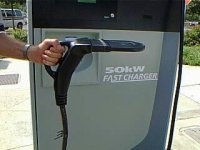JennyB
1 kW
A hundred years ago some electric cars carried a kit to allow them to take current from overhead tram. I'm wondering if an updated version is technically feasible - some sort of power source laid at road level that ordinary traffic can safely drive over. Obviously a permanently live rail with a bare-metal contact would be impractical - think of all the electrocuted roadkill. Would an inductive coil be able to efficiently transfer power from a buried cable?




